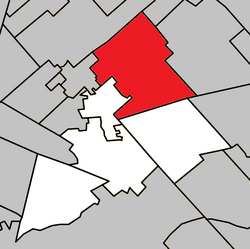Saint-Hippolyte | |
|---|---|
 Saint-Hippolyte Church, located on the town's main street, Chemin des Hauteurs | |
| Motto: Belle naturelle | |
 Location within La Rivière-du-Nord RCM | |
| Coordinates: 45°56′N 74°01′W / 45.93°N 74.02°W[1] | |
| Country | |
| Province | |
| Region | Laurentides |
| RCM | La Rivière-du-Nord |
| Constituted | July 1, 1855 |
| Government | |
| • Mayor | Yves Dagenais |
| • Federal riding | Rivière-du-Nord |
| • Prov. riding | Rousseau |
| Area | |
| • Total | 132.60 km2 (51.20 sq mi) |
| • Land | 119.50 km2 (46.14 sq mi) |
| Population | |
| • Total | 10,669 |
| • Density | 89.3/km2 (231/sq mi) |
| • Pop 2016-2021 | |
| Time zone | UTC−5 (EST) |
| • Summer (DST) | UTC−4 (EDT) |
| Postal code(s) | |
| Area code(s) | 450 and 579 |
| Highways | |
| Website | saint-hippolyte |
Saint-Hippolyte (historically Saint-Hippolyte-de-Kilkenny)[4] is a municipality within La Rivière-du-Nord Regional County Municipality in the Laurentides region of Quebec, Canada, in the Laurentian mountains about 45 km north of Montreal. The name comes from Saint Hippolytus.
Part of the town was formerly known as Abercrombie-Est.
Police services are provided by the Régie intermunicipale de police de la Rivière-du-Nord, which also serves Piedmont, Prévost and some other communities in the Laurentians.
The municipality of Saint-Hippolyte's original name was Abercrombie. The name was pick to honor James Abercrombie, british commander-in-chief of forces in North America during the French and Indian War, best known for the disastrous British losses in the 1758 Battle of Carillon. The municipality changed its name to the current Saint-Hippolyte in 1951. The name was chosen to honor Hippolyte Moreau, titular canon of the Cathedral of Montreal (1854-1880) and vicar general (1873-1880). It was his responsibility to choose the location of the church in the name of Monsignor Ignace Bourget in 1864. The name is a reference to Hippolytus of Rome, one of the most important second-third century Christian theologians.
- ^ Cite error: The named reference
toponymiewas invoked but never defined (see the help page). - ^ a b Cite error: The named reference
mamrotwas invoked but never defined (see the help page). - ^ a b Cite error: The named reference
cp2021was invoked but never defined (see the help page). - ^ admin (2020-12-04). "Logo de Saint-Hippolyte". Voyage à travers le Québec (in French). Retrieved 2024-02-09.
